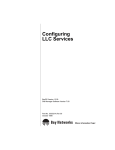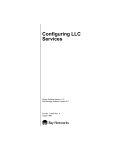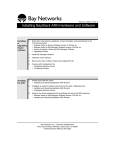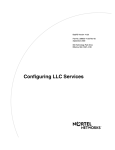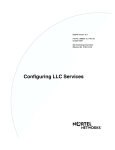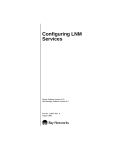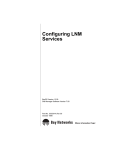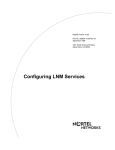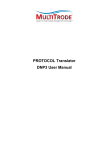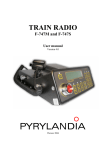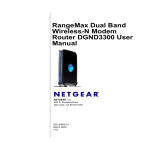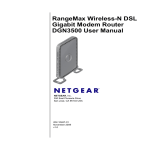Download Avaya Configuring LLC Services User's Manual
Transcript
Configuring LLC Services Router Software Version 10.0 Site Manager Software Version 4.0 Part No. 112951 Rev. A January 1996 4401 Great America Parkway Santa Clara, CA 95054 8 Federal Street Billerica, MA 01821 Copyright © 1988–1996 Bay Networks, Inc. All rights reserved. Printed in the USA. January 1996. The information in this document is subject to change without notice. The statements, configurations, technical data, and recommendations in this document are believed to be accurate and reliable, but are presented without express or implied warranty. Users must take full responsibility for their applications of any products specified in this document. The information in this document is proprietary to Bay Networks, Inc. The software described in this document is furnished under a license agreement and may only be used in accordance with the terms of that license. A summary of the Software License is included in this document. Restricted Rights Legend Use, duplication, or disclosure by the United States Government is subject to restrictions as set forth in subparagraph (c)(1)(ii) of the Rights in Technical Data and Computer Software clause at DFARS 252.227-7013. Notice for All Other Executive Agencies Notwithstanding any other license agreement that may pertain to, or accompany the delivery of, this computer software, the rights of the United States Government regarding its use, reproduction, and disclosure are as set forth in the Commercial Computer Software-Restricted Rights clause at FAR 52.227-19. Trademarks of Bay Networks, Inc. ACE, AFN, BCN, BLN, BN, CN, FRE, LN, Optivity, SynOptics, SynOptics Communications, Wellfleet and the Wellfleet logo are registered trademarks and AN, ANH, ASN, BaySIS, BayStack, BCNX, BLNX, BNX, EZ Internetwork, EZ LAN, FN, PathMan, PhonePlus, PPX, Quick2Config, RouterMan, SPEX, Bay Networks, Bay Networks Press, the Bay Networks logo and the SynOptics logo are trademarks of Bay Networks, Inc. Third-Party Trademarks All other trademarks and registered trademarks are the property of their respective owners. Statement of Conditions In the interest of improving internal design, operational function, and/or reliability, Bay Networks, Inc. reserves the right to make changes to the products described in this document without notice. Bay Networks, Inc. does not assume any liability that may occur due to the use or application of the product(s) or circuit layout(s) described herein. Portions of the code in this software product are Copyright © 1988, Regents of the University of California. All rights reserved. Redistribution and use in source and binary forms of such portions are permitted, provided that the above copyright notice and this paragraph are duplicated in all such forms and that any documentation, advertising materials, and other materials related to such distribution and use acknowledge that such portions of the software were developed by the University of California, Berkeley. The name of the University may not be used to endorse or promote products derived from such portions of the software without specific prior written permission. SUCH PORTIONS OF THE SOFTWARE ARE PROVIDED “AS IS” AND WITHOUT ANY EXPRESS OR IMPLIED WARRANTIES, INCLUDING, WITHOUT LIMITATION, THE IMPLIED WARRANTIES OF MERCHANTABILITY AND FITNESS FOR A PARTICULAR PURPOSE. In addition, the program and information contained herein are licensed only pursuant to a license agreement that contains restrictions on use and disclosure (that may incorporate by reference certain limitations and notices imposed by third parties). Bay Networks Software License Note: This is Bay Networks basic license document. In the absence of a software license agreement specifying varying terms, this license — or the license included with the particular product — shall govern licensee’s use of Bay Networks software. This Software License shall govern the licensing of all software provided to licensee by Bay Networks (“Software”). Bay Networks will provide licensee with Software in machine-readable form and related documentation (“Documentation”). The Software provided under this license is proprietary to Bay Networks and to third parties from whom Bay Networks has acquired license rights. Bay Networks will not grant any Software license whatsoever, either explicitly or implicitly, except by acceptance of an order for either Software or for a Bay Networks product (“Equipment”) that is packaged with Software. Each such license is subject to the following restrictions: 1. Upon delivery of the Software, Bay Networks grants to licensee a personal, nontransferable, nonexclusive license to use the Software with the Equipment with which or for which it was originally acquired, including use at any of licensee’s facilities to which the Equipment may be transferred, for the useful life of the Equipment unless earlier terminated by default or cancellation. Use of the Software shall be limited to such Equipment and to such facility. Software which is licensed for use on hardware not offered by Bay Networks is not subject to restricted use on any Equipment, however, unless otherwise specified on the Documentation, each licensed copy of such Software may only be installed on one hardware item at any time. 2. Licensee may use the Software with backup Equipment only if the Equipment with which or for which it was acquired is inoperative. 3. Licensee may make a single copy of the Software (but not firmware) for safekeeping (archives) or backup purposes. 4. Licensee may modify Software (but not firmware), or combine it with other software, subject to the provision that those portions of the resulting software which incorporate Software are subject to the restrictions of this license. Licensee shall not make the resulting software available for use by any third party. 5. Neither title nor ownership to Software passes to licensee. 6. Licensee shall not provide, or otherwise make available, any Software, in whole or in part, in any form, to any third party. Third parties do not include consultants, subcontractors, or agents of licensee who have licensee’s permission to use the Software at licensee’s facility, and who have agreed in writing to use the Software only in accordance with the restrictions of this license. 7. Third-party owners from whom Bay Networks has acquired license rights to software that is incorporated into Bay Networks products shall have the right to enforce the provisions of this license against licensee. 8. Licensee shall not remove or obscure any copyright, patent, trademark, trade secret, or similar intellectual property or restricted rights notice within or affixed to any Software and shall reproduce and affix such notice on any backup copy of Software or copies of software resulting from modification or combination performed by licensee as permitted by this license. Bay Networks, Inc. 4401 Great America Parkway, Santa Clara, CA 95054 8 Federal Street, Billerica, MA 01821 Bay Networks Software License (continued) 9. Licensee shall not reverse assemble, reverse compile, or in any way reverse engineer the Software. [Note: For licensees in the European Community, the Software Directive dated 14 May 1991 (as may be amended from time to time) shall apply for interoperability purposes. Licensee must notify Bay Networks in writing of any such intended examination of the Software and Bay Networks may provide review and assistance.] 10. Notwithstanding any foregoing terms to the contrary, if licensee licenses the Bay Networks product “Site Manager,” licensee may duplicate and install the Site Manager product as specified in the Documentation. This right is granted solely as necessary for use of Site Manager on hardware installed with licensee’s network. 11. This license will automatically terminate upon improper handling of Software, such as by disclosure, or Bay Networks may terminate this license by written notice to licensee if licensee fails to comply with any of the material provisions of this license and fails to cure such failure within thirty (30) days after the receipt of written notice from Bay Networks. Upon termination of this license, licensee shall discontinue all use of the Software and return the Software and Documentation, including all copies, to Bay Networks. 12. Licensee’s obligations under this license shall survive expiration or termination of this license. Bay Networks, Inc. 4401 Great America Parkway, Santa Clara, CA 95054 8 Federal Street, Billerica, MA 01821 Contents About This Guide Audience ..........................................................................................................................xiii Before You Begin .............................................................................................................xiii Bay Networks Customer Support ....................................................................................xiv CompuServe .............................................................................................................xiv InfoFACTS ................................................................................................................. xv World Wide Web ........................................................................................................ xv How to Get Help .............................................................................................................. xv Conventions .....................................................................................................................xvi Ordering Bay Networks Publications ..............................................................................xvii Acronyms ........................................................................................................................xvii Chapter 1 Logical Link Control Overview LLC 8802/802.2 Standards .............................................................................................1-1 LLC and SNA ..................................................................................................................1-3 LLC and Non-SNA Protocols ..........................................................................................1-3 Supported Media ............................................................................................................1-3 LLC Service Classes ......................................................................................................1-4 LLC1 (Connectionless Service) ...............................................................................1-4 LLC2 (Connection-Oriented Service) .......................................................................1-4 LLC Operation Types ......................................................................................................1-5 Type 1 Operations ....................................................................................................1-5 Type 2 Operations ....................................................................................................1-6 LLC Functionality ............................................................................................................1-6 LLC Protocol Data Unit Formats .....................................................................................1-7 Destination SAP (DSAP) ..........................................................................................1-8 Source SAP (SSAP) .................................................................................................1-8 SAP Addressing Scheme .........................................................................................1-9 v Control Field ...........................................................................................................1-11 Control Field Formats .............................................................................................1-12 Information Field ....................................................................................................1-16 For More Information about Logical Link Control ..........................................................1-17 Chapter 2 LLC2 Routed over Frame Relay Compatibility with RFC 1490 ..........................................................................................2-1 Compatibility with IBM NCP 7.1 and Higher ...................................................................2-1 FRAD-like Functionality ..................................................................................................2-4 Mapping DLCIs to MAC Addresses ................................................................................2-4 Router Mapping Examples .............................................................................................2-5 Virtual MAC to Frame Relay .....................................................................................2-6 Frame Relay to Virtual MAC .....................................................................................2-7 Physical MAC to Frame Relay ..................................................................................2-8 Frame Relay to Physical MAC ..................................................................................2-9 Frame Relay to Frame Relay ..................................................................................2-10 LLC2 over Frame Relay: Routed versus Bridged .........................................................2-11 For More Information about LLC2 over Frame Relay ...................................................2-12 Chapter 3 Enabling LLC Services Using the Parameter Descriptions ..................................................................................3-1 Enabling LLC2 on an Interface .......................................................................................3-2 Enabling LLC2 Services over Native Frame Relay .........................................................3-3 For APPN Networks .................................................................................................3-4 For DLSw Networks .................................................................................................3-5 Chapter 4 Editing LLC Parameters Configuring LLC Parameters ..........................................................................................4-2 Editing LLC2 Global Parameters ....................................................................................4-3 Editing LLC2 Interface Parameters .................................................................................4-4 Editing Frame Relay Mappings .....................................................................................4-13 Deleting an LLC2 Interface ...........................................................................................4-14 Editing LLC2 Inbound Traffic Filters ..............................................................................4-14 Deleting LLC2 from the Node .......................................................................................4-14 vi Appendix A LLC2 Default Settings Index vii Figures Figure 1-1. Figure 1-2. Figure 1-3. Figure 1-4. Figure 1-5. Figure 1-6. Figure 2-1. Figure 2-2. Figure 2-3. Figure 2-4. Figure 2-5. Figure 2-6. Figure 2-7. Figure 3-1. Figure 3-2. Figure 3-3. Figure 3-4. Figure 3-5. Figure 3-6. Figure 3-7. Figure 4-1. Figure 4-2. Figure 4-3. Figure 4-4. The LLC Sublayer in the IEEE 802.x and OSI Models .............................1-2 LLC PDU Structure ..................................................................................1-7 DSAP Address Field ................................................................................1-8 SSAP Address Field ................................................................................1-9 SAPs for LLC Clients .............................................................................1-10 LLC PDU Control Field Format ..............................................................1-12 Sample Frame Relay Network Using LLC2 .............................................2-3 Virtual MAC to Frame Relay Topology .....................................................2-6 Frame Relay to Virtual MAC Topology .....................................................2-7 Physical MAC to Frame Relay Topology ..................................................2-8 Frame Relay to Physical MAC Topology ..................................................2-9 Frame Relay-to-Frame Relay Topology ..................................................2-10 RFC 1490 Bridging and Routing Standards for SNA .............................2-11 Select Protocols Window (LLC only) ........................................................3-2 WAN Protocols Window (Frame Relay) ...................................................3-3 Select Protocols Window .........................................................................3-4 Source Route Encapsulation Dialog Box .................................................3-4 LLC2 Frame Relay Mappings Window .....................................................3-6 LLC2 Frame Relay Mapping Add Window ...............................................3-7 LLC2 Frame Relay Mappings Window with DLCI Added .........................3-9 Configuration Manager Window ...............................................................4-2 Edit LLC2 Global Parameters Window .....................................................4-3 LLC2 Interface Configuration Window .....................................................4-5 LLC2 Interface Configuration Window (Bottom) .......................................4-5 ix Tables Table 1-1. Table 1-2. Table 1-3. Table 1-4. Table A-1. Table A-2. LLC Command PDUs ..............................................................................1-7 PDU Format and Functional Purpose ....................................................1-13 Control Field Bits and Functional Purpose ............................................1-13 Command Names and Definitions .........................................................1-14 LLC2 Global Parameters ........................................................................ A-1 LLC2 Interface Parameters ..................................................................... A-1 xi About This Guide Customizing your Bay Networks routers for Logical Link Control (LLC) services opens your network to LAN Network Manager (LNM) servers, Data Link Switching (DLSw) services, and Advanced Peer-to-Peer Networking (APPN). To add these services, you need to read about • The LLC protocol and its client protocols (see Chapter 1) • LLC2 over Frame Relay (see Chapter 2) • Enabling LLC (see Chapter 3) • Editing LLC parameters (see Chapter 4) Audience Written for system and network managers, this guide describes how to configure the Bay Networks implementation of LLC to suit your environment. Before You Begin Before using this guide, you must complete the following procedures: • Open a configuration file • Specify the router hardware, if this is a local-mode configuration file • Select the link- or net-module connector on which you are enabling LLC Refer to Configuring Routers for instructions. xiii Configuring LLC Services Bay Networks Customer Support Bay Networks provides live telephone technical support to our distributors, resellers, and service-contracted customers from two U.S. and three international support centers. If you have purchased your Bay Networks product from a distributor or authorized reseller, contact the technical support staff of that distributor or reseller for assistance with installation, configuration, troubleshooting, or integration issues. Customers also have the option of purchasing direct support from Bay Networks through a variety of service programs. The programs include priority access telephone support, on-site engineering assistance, software subscription, hardware replacement, and other programs designed to protect your investment. To purchase any of these support programs, including PhonePlus™ for 24-hour telephone technical support, call 1-800-2LANWAN. Outside the U.S. and Canada, call (408) 764-1000. You can also receive information on support programs from your local Bay Networks field sales office, or purchase Bay Networks support directly from your reseller. Bay Networks provides several methods of receiving support and information on a nonpriority basis through the following automated systems. CompuServe Bay Networks maintains an active forum on CompuServe. All you need to join us online is a computer, a modem, and a CompuServe account. We also recommend using the CompuServe Information Manager software, available from CompuServe. The Bay Networks forum contains libraries of technical and product documents designed to help you manage and troubleshoot your Bay Networks products. Software agents and patches are available, and the message boards are monitored by technical staff and can be a source for problem solving and shared experiences. Customers and resellers holding Bay Networks service contracts can visit the special libraries to acquire advanced levels of support documentation and software. To open an account and receive a local dial-up number, call CompuServe at 1-800-524-3388 and ask for Representative No. 591. • xiv In the United Kingdom, call Freephone 0800-289378. About This Guide • In Germany, call 0130-37-32. • In Europe (except for the United Kingdom and Germany), call (44) 272-760681. • Outside the U.S., Canada, and Europe, call (614) 529-1349 and ask for Representative No. 591, or consult your listings for an office near you. Once you are online, you can reach our forum by typing the command GO BAYNETWORKS at any ! prompt. InfoFACTS InfoFACTS is the Bay Networks free 24-hour fax-on-demand service. This automated system contains libraries of technical and product documents designed to help you manage and troubleshoot your Bay Networks products. The system can return a fax copy to the caller or to a third party within minutes of being accessed. World Wide Web The World Wide Web (WWW) is a global information system for file distribution and online document viewing via the Internet. You need a direct connection to the Internet and a Web Browser (such as Mosaic or Netscape). Bay Networks maintains a WWW Home Page that you can access at http://www.baynetworks.com. One of the menu items on the Home Page is the Customer Support Web Server, which offers technical documents, software agents, and an E-mail capability for communicating with our technical support engineers. How to Get Help For additional information or advice, contact the Bay Networks Technical Response Center in your area: United States Valbonne, France Sydney, Australia Tokyo, Japan 1-800-2LAN-WAN (33) 92-966-968 (61) 2-903-5800 (81) 3-328-005 xv Configuring LLC Services Conventions This section describes the conventions used in this guide. angle brackets (< >) Indicate that you choose the text to enter based on the description inside the brackets. Do not type the brackets when entering the command. Example: if command syntax is ping <ip_address>, you enter ping 192.32.10.12 arrow character (➔) Separates menu and option names in instructions. Example: Protocols➔AppleTalk identifies the AppleTalk option in the Protocols menu. bold text Indicates text that you need to enter and command names in text. Example: Use the dinfo command. brackets ([ ]) Indicate optional elements. You can choose none, one, or all of the options. italic text Indicates variable values in command syntax descriptions, new terms, file and directory names, and book titles. quotation marks (“ ”) Indicate the title of a chapter or section within a book. screen text Indicates data that appears on the screen. Example: Set Bay Networks Trap Monitor Filters ellipsis points vertical line (|) . Horizontal (. . .) and vertical ( .. ) ellipsis points indicate omitted information. Indicates that you enter only one of the parts of the command. The vertical line separates choices. Do not type the vertical line when entering the command. Example: If the command syntax is show at routes | nets, you enter either show at routes or show at nets, but not both. xvi About This Guide Ordering Bay Networks Publications To purchase additional copies of this document or other Bay Networks publications, order by part number from Bay Networks Press™ at the following numbers. You may also request a free catalog of Bay Networks Press product publications. Phone: FAX - U.S./Canada: FAX - International: 1-800-845-9523 1-800-582-8000 1-916-939-1010 ANSI American National Standards Institute APPN Advanced Peer-to-Peer Networking DLCI data link connection identifier DLSw Data Link Switching DSPU downstream physical unit FDDI Fiber Distributed Data Interface FEP front-end processor FR Frame Relay FRAD Frame Relay Access Device IEEE Institute of Electrical and Electronic Engineers ISO International Standards Organization LAN local area network LLC Logical Link Control LNM LAN Network Manager LSAP link service access point LSB least significant bit LSDU link service data unit MAC media access control MSB most significant bit NCP Network Communications Program NetBIOS Network Basic Input-Output System OSI Open Systems Interconnection Acronyms xvii Configuring LLC Services xviii PDU protocol data unit RFC Request for Comment SAP service access point SDLC Synchronous Data Link Control SNA Systems Network Architecture SR source routing SRB source-route bridging WAN wide area network Chapter 1 Logical Link Control Overview LLC is a standard protocol within the CCITT 8802.2 and IEEE 802.x family of LAN standards. Other protocols such as IBM Systems Network Architecture (SNA), Novell NetWare, and DECnet use LLC services for end-to-end communication in a LAN environment. The Bay Networks implementation of the LLC protocol consists of LLC Class 1 (LLC1), a connectionless service, and LLC Class 2 (LLC2), a connection-oriented service. A Bay Networks router configured for LLC supports • Data Link Switching (DLSw), as defined in RFC 1434 and Configuring DLSw Services • Advanced Peer-to-Peer Networking (APPN), as defined in Configuring APPN Services • LAN Network Manager (LNM), as defined in Configuring LNM Services LLC 8802/802.2 Standards The LLC protocols comply with the CCITT 8802.2 standard, and operate within the IEEE Project 802.x protocol stack. Figure 1-1 compares LLC’s location in the 802.x protocol stack to its equivalent position in the ISO/OSI model. 1-1 Configuring LLC Services Application Presentation Session IEEE 802 Model Transport 802.1 Network 8022 (LLC) Data Link MAC Physical Figure 1-1. Physical The LLC Sublayer in the IEEE 802.x and OSI Models You can add an IEEE 802.2-compliant LLC interface to any physical circuit attached directly to an 8802.x/802.x LAN segment. Each interface services higher-level clients (networking protocols and applications) and is serviced by lower-level protocols (media access control [MAC] and physical layers) operating within the router. Certain protocols on a Bay Networks router automatically configure a supporting LLC1 (default) interface and, if needed, a configurable LLC2 interface on the same circuit. For example, Bay Networks routers in your corporate network may need to support sessions between an LNM workstation (client) and multiple Token Ring LANs in that network. In this case, Site Manager enables you to add an LNM Servers subsystem to any Token Ring circuit on the router. The LNM Servers on a Token Ring circuit automatically configure an LLC1 and an LLC2 interface on the same physical circuit. 1-2 Logical Link Control Overview Both APPN and DLSw support a default LLC configuration. You can customize the operation of any LLC2 interface that the router automatically adds to the configuration using the Configuration Manager software. LLC and SNA SNA needs a connection-oriented datalink layer for end-to-end packet sequencing and error control. Over wide area networks (WANs), the Synchronous Data Link Control (SDLC) protocol has traditionally met this need. However, in a LAN environment, front-end processors (FEPs), controllers, and NetBIOS client/server stations commonly use an LLC2 layer for this purpose. To support communication among these devices, you can add LLC2 interfaces to a router configuration. SNA devices and NetBIOS PCs use LLC when they establish sessions through a LAN topology. SNA and NetBIOS need LLC2 connection-oriented circuits to provide higher-layer sequencing and error control in bridged LAN environments. LLC2 works much like SDLC in terms of packet sequencing and acknowledgment, but, unlike SDLC, it does not impose unbalanced, primary/secondary relationships between communicating nodes; any LLC station can initiate a peer-to-peer conversation with any other LLC station. LLC and Non-SNA Protocols Though TCP/IP, NetWare, DECnet, and other internetworking protocols do not require an LLC connection-oriented datalink layer (their network and transport layers provide the required functions), these protocols can, in fact, use LLC1 services if you so elect. You add LLC1 interfaces to a router configuration to support these higher-level protocols. Supported Media DLSw and APPN with LLC2 run over the following: • Token Ring • Ethernet • Synchronous media • FDDI 1-3 Configuring LLC Services LLC2 runs over source route bridging (SRB) on all media. LLC2 also runs over the transparent bridge on Ethernet. Every interface to Ethernet, however, must have LLC2 and either the DLSw or APPN protocol enabled. LLC supports routed, native Frame Relay. It conforms to RFC 1490. LNM with LLC runs over Token Ring only. LLC Service Classes The 802.2/LLC recommendations support three service classes: • Connectionless Unacknowledged (Class 1 or LLC1) • Connection-Oriented (Class 2 or LLC2) • Connectionless Acknowledged (Class 3 or LLC3 ) Note: Bay Networks LLC does not support the LLC3 service class. LLC1 (Connectionless Service) LLC1 is a datagram service that sends and receives LLC frames called link service data units (LSDUs) without requiring acknowledgment from the peer to assure delivery. LLC1 supports all forms of communication (point-to-point, multipoint/multicast, and broadcast). This service is appropriate for protocols that provide addressing, routing, recovery, and sequencing services at a higher layer. LLC2 (Connection-Oriented Service) LLC2 secures a point-to-point virtual circuit connection between link service access points (LSAPs). The LLC2 protocol • 1-4 Responds to a request from a higher-level protocol to open a connection through the datalink layer Logical Link Control Overview • Notifies a higher-level protocol that a connection through the datalink layer has been established successfully • Enables a higher-level protocol to — Send or receive LSDUs over an established datalink-layer connection — Sequence LSDUs sent over a datalink-layer connection — Control the flow of LSDUs over a datalink-layer connection The LLC2 service also • Responds to a request from a higher-level protocol to reset a connection to its initially connected state • Responds to a request from a higher-level protocol to close an established connection • Notifies a higher-level protocol that a connection previously established has been closed successfully Because the connection occurs in the datalink layer rather than in higher layers, LLC2 performs frame sequencing, flow control, and error recovery services for the datalink layer. LLC Operation Types LLC supports two operation types: • Unnumbered, Unacknowledged (Type 1) • Numbered, Acknowledged (Type 2) LLC1 supports only Type 1 operations; LLC2 supports both Type 1 and Type 2 operations. Type 1 Operations Type 1 operations have the following characteristics: • LLCs exchange protocol data units (PDUs) without establishing a datalink connection. • The peer does not acknowledge the PDUs it receives. 1-5 Configuring LLC Services • There are no mechanisms for PDU sequencing, flow control, or error recovery, because higher-level protocols perform these services. Type 2 Operations Type 2 operations have the following characteristics: • The LLC and its peer must establish a datalink-layer virtual circuit/connection prior to any exchange of data. • The source and destination are peer LLCs in an asynchronous, balanced datalink connection. • The source and destination LLCs control traffic by means of a numbering scheme for the sequential transfer of PDUs. The PDUs for each virtual circuit/connection have independent sequence-numbering schemes. • The destination LLC acknowledges data PDUs that the source LLC sends by informing the source LLC of the next sequence number expected. LLC Functionality The LLC sublayer can support multiple logical links concurrently. The LLC protocols generate and interpret command packets or frames called protocol data units (PDUs), which Table 1-1 describes. The LLC sublayer • Initiates and terminates control signal interchange with the XID, TEST, SABME, and DISC PDUs. • Organizes data flow with the U, I, and UA PDUs. The level of organization differs between Type 1 and Type 2 operations. • Interprets command PDUs it receives, and generates appropriate response PDUs, which differ between Type 1 and Type 2 operations and LLC1 and LLC2 service. • Manages error control and recovery with the REJ, RR, RNR, and FRMR PDUs. Table 1-1 lists Type 1 and Type 2 command PDUs and their counterpart response PDUs: • 1-6 Type 1 operations do not include definition of an Acknowledgment PDU. Logical Link Control Overview • Type 2 operations do not include a command PDU counterpart for the FRMR response PDU. Table 1-1. LLC Command PDUs Operation Type Command Response Type 1 Unnumbered Information (UI) No response Exchange Identification (XID) Exchange Identification (XID) Test (TEST) Test (TEST) Information (I) Information (I) Receiver Ready (RR) Receiver Ready (RR) Receiver Not Ready (RNR) Receiver Not Ready (RNR) Reject (REJ) Reject (REJ) Set Asynchronous Balanced Mode Extended (SABME) Unnumbered Acknowledgment (UA) Disconnect (DISC) Disconnected Mode (DM) No command Frame Reject (FRMR) Type 2 LLC Protocol Data Unit Formats The LLC protocol data unit (PDU) contains fields for addressing, control, and data, as shown in Figure 1-2. This section provides additional information on each field of the LLC PDU. DSAP SSAP Control Information Field 8 bits 8 bits 8 or 16 bits Variable; 8 bits each packet Figure 1-2. LLC PDU Structure 1-7 Configuring LLC Services Destination SAP (DSAP) The DSAP Address field identifies one or more service access points (SAPs) for which the LLC PDU is intended. The DSAP field contains 7 bits of actual address and 1 Address Designation bit to indicate an Individual (I) destination address or a Group (G) destination address, as shown in Figure 1-3. Address Designation Bit D D D D D D D Figure 1-3. I/G DSAP Address Field • A value of 0 for the Address Designation bit indicates that the PDU is destined for an individual SAP. • A value of 1 for the Address Designation bit indicates that the PDU is destined for a group-level SAP. Source SAP (SSAP) The SSAP Address field identifies the specific service access point that initiated the PDU. The SSAP field contains 7 bits of actual address and 1 Command/Response Identifier bit to indicate that the LLC PDU is a Command (C) PDU or a Response (R) PDU, as shown in Figure 1-4. 1-8 Logical Link Control Overview Command/Response Identifier Bit S S S S S S S Figure 1-4. C/R SSAP Address Field • A value of 0 for the Command/Response Identifier bit indicates that the PDU is a Command PDU. • A value of 1 for the Command/Response Identifier bit indicates that the PDU is a Response PDU. SAP Addressing Scheme All of the 802.2/LLC protocols provide a SAP addressing scheme that lets multiple applications and protocol entities in a single machine share a MAC address. Popular network protocols such as LAN Network Manager, NetBIOS, and SNA all have published SAP addresses, but any application can use a SAP to send or receive data via the LLC sublayer. The LLC SAP function sorts frames coming up from the MAC layer and directs them to the appropriate application or protocol software entity. Figure 1-5 illustrates some SAPs published for NetBIOS and SNA. The xx denotes all other published and unpublished SAPs. 1-9 Configuring LLC Services Applications NetBIOS SNA Path Control (For LANattached devices) (Used by DLSw and APPN) SAP F0 SAP 04 LAN Network Manager (Other) SAP F4 SAP xx LLC MAC Figure 1-5. SAPs for LLC Clients SAP addresses can be 1-10 • Individual — Designates a single SAP. The individual address is usable as both an SSAP and a DSAP. The individual SAP has an Address Designation bit value of 0. • Group — Designates a group of DSAPs. The group DSAP has an Address Designation bit value of 1. • Global — Designates a group consisting of all DSAPs that the underlying MAC SAP addresses actively service. The global DSAP has a value of all 1s. • Null — Designates the SAP of the underlying MAC sublayer and does not identify any SAP to the network layer or any SAP to an associated layer management function. The Null address is usable as both an SSAP and a DSAP. The Null SAP has a value of all 0s. Logical Link Control Overview Control Field The Control field consists of one or two octets that designate command and response functions. It also contains sequence numbers when required. The format of the Control field of the LLC PDU defines the type of operation (Type 1 versus Type 2): • Information (an I format PDU) • Supervisory (an S format PDU) • Unnumbered (a U format PDU) Figure 1-6 shows the three Control field formats. 1-11 Configuring LLC Services 8 7 6 I format PDU Information Transfer Commands/Responses S format PDU Supervisory Commands/Responses 3 2 N(S) X U format PDU Unnumbered Commands/Responses M X M N(S) Send Sequence Number N(R) Receive Sequence Number S Supervisory function bit M Modifier function bit X Reserved and set to zero P/F Poll/Final bit Figure 1-6. Bit 4 5 X M 1 8-2 0 X S S 0 P/F M M 1 1 1 N(R) P/F N(R) P/F 1 LLC PDU Control Field Format Control Field Formats Table 1-2 further defines the purpose of the three PDU types, where the specific format in the PDU Control field determines the type. 1-12 Logical Link Control Overview Table 1-2. PDU Format and Functional Purpose Format Function Information Transfer Format (I) The I format PDU performs a numbered information transfer in Type 2 operation. Except for the UI, TEST, FRMR, and XID command/response PDUs, the I format PDU is the only LLC PDU that can contain an Information field. (Refer to “Information Field” later in this chapter for more details.) Supervisory Format (S) The S format PDU performs datalink supervisory control functions in Type 2 operation, such as acknowledging I format PDUs, requesting retransmission of I format PDUs, and requesting a temporary suspension of transmission of I format PDUs. Unnumbered Format (U) The U format PDU is available for Type 1 or Type 2 operations, and provides additional datalink control functions and unsequenced information transfer. Table 1-3 further defines the purpose of parameter bits in the PDU Control field. Table 1-3. Control Field Bits and Functional Purpose Bit Purpose Send Sequence Number N(S) Bit Only I PDUs contain N(S), which is the sequence number of the PDU being transmitted. Receive Sequence Number N(R) Bit I PDUs contain N(R), which is the sequence number of the PDU an LLC expects to receive next on the specified datalink connection. Poll/Final (P/F) Bit The P/F bit solicits (polls) a response from the addressed LLC. The Final (F) bit indicates the response PDU sent as a result of a soliciting (poll) command. 1-13 Configuring LLC Services Table 1-4 further defines the purpose of each command and response PDU. Table 1-4. Command Names and Definitions Control Field Value Definition Unnumbered Information (UI) 0x13 or 0x03 Transports information to one or more LLCs. Since this is a Type 1 operation, there is no corresponding response/reply PDU. Exchange Identification (XID) 0xBF or 0xAF The XID command PDU conveys to the destination LLC: • The types of LLC services the source LLC supports • The receive window size the source LLC supports per datalink connection (per virtual circuit) The XID response PDU identifies the responding LLC and conveys to the source LLC: • The types of LLC services the destination LLC supports • The receive window size the destination LLC supports per datalink connection (per virtual circuit) Test (TEST) 0xF3 or 0xE3 The TEST command PDU causes the destination LLC to respond with the TEST response PDU; it performs a loopback test of the LLC-to-LLC transmission paths. The TEST command PDU also initiates the establishment of an LLC1 logical link across a network to another LLC entity. The TEST response PDU confirms the establishment of an LLC1 link. Information (I) 6xxx0 or xx even The I command PDU indicates to the destination LLC: • The sequence number for each I command PDU • The I PDU sequence number the destination LLC expects next The I command PDU also serves as an I response PDU by indicating to the destination LLC that the source LLC has received I PDUs up to a designated number from that destination LLC. Command/Res ponse (continued) 1-14 Logical Link Control Overview Table 1-4. Command Names and Definitions (continued) Command/Res ponse Control Field Value Definition Receiver Ready (RR) 01xx The RR command PDU indicates that the source LLC is ready to receive an I PDU. The sending LLC then considers I PDUs sent prior to the RR condition as acknowledged. Receiver Not Ready (RNR) 05xx The RNR command PDU notifies the destination LLC that the originating LLC is busy and temporarily unable to receive I PDUs. RNRs, combined with RRs, control flow between source and destination LLC interfaces. Reject (REJ) 09xx The REJ command PDU conveys a request to the peer LLC to retransmit I PDUs, starting with the I PDU that the REJ command designates. Set Asynchronous Balanced Mode Extended (SABME) 7F or 6F The SABME command PDU establishes an LLC2 connection to the destination LLC. The connection operates in asynchronous balanced mode. Disconnect (DISC) 53 or 43 If the destination LLC receives from its network layer a DataLink Connect request, the destination LLC responds to the SABME PDU with a UA PDU. If the destination LLC receives from its network layer a DataLink Disconnect request, it does not send a UA PDU. The DISC response PDU closes an open connection by initiating a SABME command. The DISC PDU informs the destination LLC that the source LLC is suspending the datalink connection, and the destination LLC should assume the Disconnected Mode. Prior to acting on the DISC command, the destination LLC must confirm the acceptance of the DISC command PDU by sending a UA response PDU. I PDUs sent previously but not acknowledged remain unacknowledged. (continued) 1-15 Configuring LLC Services Table 1-4. Command Names and Definitions (continued) Command/Res ponse Control Field Value Definition Unnumbered Acknowledg-me nt (UA) 73 or 63 The UA response PDU acknowledges the receipt and acceptance of a SABME or DISC command PDU relating to a specific datalink connection to be opened or closed, as appropriate for the type of command PDU it has received. Disconnected Mode (DM) 1F or 0F The DM response PDU indicates that the LLC sending the response is logically disconnected from the datalink connection. Frame Reject (FRMR) 97 or 87 The FRMR command PDU reports to the sending LLC that an uncorrectable condition was detected in a received frame. The FRMR PDU includes an information field that indicates the reason for the PDU rejection. The LLC receiving the FRMR PDU • Initiates the appropriate mode setting • Initiates corrective action by reinitializing transmission in both directions on the datalink connection, using the SABME and DISC command PDUs, as appropriate Information Field The contents of the Information field depend on the type of PDU in which it appears, as follows: • The Information field of an I format PDU contains only user data. • The Information field of a UI command/response PDU also contains only user data. • The Information field of a TEST command/response PDU is optional and contains a test pattern used for LLC loopback testing. • The Information field of an XID command/response PDU contains — An 8-bit XID format identifier field — A 16-bit parameter field encoded to identify the LLC services supported, plus the maximum receive window size 1-16 Logical Link Control Overview • The Information field of an FRMR PDU contains the reason for PDU rejection by an LLC. (The contents of the Information field of an FRMR PDU is beyond the scope of this publication. For more details on the FRMR PDU, refer to the ISO 8802/IEEE Std 802.2 1989.) For More Information about Logical Link Control The following publications give technical details on 802.2/Logical Link Control, Token Ring LANs, DLSw, APPN, IBM LAN Network Manager, and LNM Servers: • Institute of Electrical and Electronics Engineers. International Standard ISO 8802-2/ANSI/IEEE Std 802.2 1989. Information Processing Systems, Local Area Networks, Part 2: Logical Link Control. Washington, D.C., 1989. • IBM Corporation, SC30-3374-02. IBM Token Ring Network Architecture Reference. 3rd ed. September 1989. • IBM Corporation, 31G6962. IBM LAN Network Manager User’s Guide. • Perlman, Radia. Interconnections: Bridges and Routers. Reading, Massachusetts: Addison-Wesley Publishing Company, 1992. 1-17 Chapter 2 LLC2 Routed over Frame Relay LLC2 (connection-oriented service) in a Bay Networks router supports Frame Relay with both Data Link Switching (DLSw) and Advanced Peer-to-Peer Networking (APPN), based on RFC 1490. Compatibility with RFC 1490 RFC 1490 describes an encapsulation method for carrying internetworking traffic over a Frame Relay backbone. The description covers both bridging and routing standards. The Bay Networks router implementation of LLC exceeds RFC 1490 (SNA encapsulation in Frame Relay only) by complying with the Frame Relay Forum’s “Protocol Encapsulation over Frame Relay Implementation Agreements.” The latter description not only defines how routed SNA traffic traverses a Frame Relay network, but also adds RFC 1490 support for Frame Relay to DLSw and APPN. This feature allows native SNA traffic originating from SDLC-, Token Ring-, or Ethernet-attached devices to communicate over public or private Frame Relay networks directly with IBM 3745 or 3746 communications controllers. It operates on all Bay Networks routers that include a Frame Relay interface. Devices can communicate with intermediate routing nodes or in a single-switch configuration similar to a standalone Frame Relay Access Device (FRAD). Compatibility with IBM NCP 7.1 and Higher LLC2 routed over Frame Relay is fully compatible with IBM NCP 7.1 and higher, and with existing or new IBM equipment. The service has passed IBM interoperability testing. You can use it without upgrading your LAN-based downstream physical units (DSPUs) or network type, such as APPN or IP. 2-1 Configuring LLC Services DSPUs attached to the router retain full visibility for IBM NetView management. The router passes through all NetView commands for the DSPUs and any Alerts generated by the DSPUs. You can configure a network without a router at the host, if the communications controller is directly attached to a Frame Relay network. Some terminals can also connect directly to the Frame Relay network without a router. Frame Relay networks save the expense of leased lines. Additional savings accrue because one port on a communications controller can support hundreds of data link connection identifiers (DLCIs). Bay Networks interoperates with NCP 7.1 and higher with software only, eliminating the need for any new hardware or upgrades to existing SNA terminals or router equipment. Figure 2-1 illustrates the connection of an SNA host through a Frame Relay network in a configuration with multiprotocol traffic to other locations. LLC can also route SDLC and Ethernet traffic, in addition to APPN, Token Ring, and IP traffic. 2-2 LLC2 Routed over Frame Relay SNA Host IBM Communications Controller with NCP (No Router Required) Frame Relay Network Bay Networks Router with DLSw or APPN APPN Figure 2-1. Token Ring IP Sample Frame Relay Network Using LLC2 2-3 Configuring LLC Services FRAD-like Functionality Token Ring, Ethernet, and SDLC endstations communicate with a Frame Relay attached host via Frame Relay Access Devices (FRADs). The Bay Networks router with DLSw operating in single-switch mode has FRAD-like capability, supporting Token Ring, Ethernet, and SDLC endstations. The router performs the following actions: • Terminates the Data Link Control level sessions • Strips the link-level header off the SNA packet • Puts an RFC1490 LLC header on the SNA packet • Sends packets into the Frame Relay network Mapping DLCIs to MAC Addresses The Frame Relay network provides a number of permanent virtual circuits (PVCs) that form the basis for connections between devices attached to the same Frame Relay network. Each virtual circuit is uniquely identified at each Frame Relay interface by a DLCI. The Frame Relay interface allows either group or direct (single) assignment of DLCIs. Group assignment allows many DLCIs per circuit; direct assignment allows only one. The system administrator or Frame Relay provider assigns DLCIs. To communicate with an IBM host, you must associate the MAC address of your DSPU with a DLCI. You can accomplish this task in one of two ways: • Create a virtual MAC address, formed by preceding the DLCI address, such as 100 (decimal), with a unique mask, such as 0x400000FF, to make a valid MAC address, for example, 400000FF0064. (Decimal 100 is 64 hexadecimal.) When the router receives an LLC frame from the DLSw network with a destination MAC (dmac) starting with the virtual MAC mask, it can automatically translate it into a DLCI, so no mapping table is needed at the Frame Relay interface. • 2-4 Use the endstation’s physical or locally configured MAC address. In this case, be aware that if you change your hardware or endstation configuration, you have to reconfigure the DLCI mapping table. LLC2 Routed over Frame Relay When the router receives an LLC frame from the DLSw network with a dmac not starting with the virtual MAC mask, the mapping table at the Frame Relay interface translates the dmac into a DLCI. SDLC single switched over LLC does not require address mapping if a virtual MAC address is used to access the host. But you still have to define DLCIs. Usually you configure only the remote MAC in the mapping table, setting it equal to the remote host MAC address. (A host may be an IBM mainframe.) You must configure the local MAC in the mapping table only if the Frame Relay interface receives connection requests. Usually only local (workstation) nodes will request a connection, so you configure only the remote MAC address. Router Mapping Examples Some sample network configurations with associated mapping tables follow, including: • Virtual MAC to Frame Relay • Frame Relay to Virtual MAC • Physical MAC to Frame Relay • Frame Relay to Physical MAC • Frame Relay to Frame Relay Although these network configurations illustrate topologies with two routers, the same principles apply for DLSw operating in single-switch mode. Instead of configuring a single interface on each router, you configure two interfaces on a single router. 2-5 Configuring LLC Services Virtual MAC to Frame Relay Figure 2-2 illustrates a sample virtual MAC address to Frame Relay DLCI mapping. In this illustration, the PC makes connection requests to Host 1 and Host 2. The workstation administrator has control over the PC configuration and has configured the remote host addresses as virtual MAC addresses corresponding to the DLCIs assigned to the hosts. Configuring the PC in this way simplifies the router configuration because a mapping table is not necessary in the Frame Relay-attached Router B. The connection request received at Router A will have a source MAC address of the PC MAC and a destination MAC address of Remote Host 1 or 2. Configuration at PC: Remote Host 1: 400000FF0064 (64 Hex = 100 Decimal) Remote Host 2: 400000FF0065 (65 Hex = 101 Decimal) PC MAC: 400000000003 Host 1 DLCI 100 PC FrameRelay Relay Frame Token Ring DLCI 101 Host 2 DLSw Router B Router A Source MAC (smac) = PC MAC Destination MAC (dmac) = Remote Host 1 or 2 Figure 2-2. 2-6 Connection Request Virtual MAC to Frame Relay Topology No Mapping LLC2 Routed over Frame Relay Frame Relay to Virtual MAC Figure 2-3 illustrates a sample Frame Relay DLCI to virtual MAC address mapping. In this network, Host 1 and Host 2 can make connection requests to the PC. The workstation administrator has control over the PC configuration and has configured the remote host addresses as virtual MAC addresses corresponding to the DLCIs assigned to the hosts. At Router B, a mapping table maps the Host 1 and Host 2 DLCIs to the PC MAC address. Router B first creates a connection request with the source MAC addresses equal to the virtual MAC address corresponding to the Host 1 and Host 2 DLCIs. Router B then creates a connection request with the destination MAC equal to the local MAC address from the mapping table. Router B always sets the source MAC address equal to the virtual MAC address, even if there is a remote MAC address configured in the mapping table. Configuration at PC: Remote Host 1: 400000FF0064 (64 Hex = 100 Decimal) Remote Host 2: 400000FF0065 (65 Hex = 101 Decimal) PC MAC: 400000000003 Host 1 DLCI 100 PC FrameRelay Relay Frame Token Ring DLCI 101 Host 2 DLSw Router B Router A Mapping Table for Router B Connection Request Source MAC (smac) = virtual Destination MAC (dmac) = 400000000003 Figure 2-3. DLCI 100 101 Remote MAC Local MAC 400000000003 400000000003 Frame Relay to Virtual MAC Topology 2-7 Configuring LLC Services Physical MAC to Frame Relay Figure 2-4 illustrates a sample physical MAC address to Frame Relay DLCI mapping. In this network, the PC makes connection requests to Host 1 and Host 2. The workstation administrator does not have control over the PC configuration and must use a configuration with real, physical MAC addresses for the remote hosts. At Router B, a mapping table maps Host 1 and 2 to the DLCIs assigned to the hosts. The connection request received at Router A will have the source MAC address of the PC MAC, and a destination MAC address of Remote Host 1 or 2. Configuration at PC: Remote Host 1: 400000000001 Remote Host 2: 400000000002 PC MAC: 400000000003 Host 1 DLCI 100 PC FrameRelay Relay Frame Token Ring DLCI 101 Host 2 DLSw Router B Router A Connection Request Mapping Table for Router B Remote MAC Source MAC (smac) = PC MAC Destination MAC (dmac) = Remote Host 1 or 2 Figure 2-4. 2-8 Physical MAC to Frame Relay Topology 400000000001 400000000002 Local MAC DLCI 100 101 LLC2 Routed over Frame Relay Frame Relay to Physical MAC Figure 2-5 illustrates a sample Frame Relay DLCI to Physical MAC mapping. In this network, Host 1 and Host 2 can make connection requests to the PC. The workstation administrator does not have control over the PC configuration and must use a configuration with real, physical MAC addresses for the remote hosts. Router B requires a mapping table to map the Host 1 and Host 2 DLCIs to the PC MAC address. Router B creates a connection request with the source MAC address equal to the virtual MAC address corresponding to the Host 1 and Host 2 DLCIs. Router B also creates a connection request with the destination MAC address equal to the local MAC address from the mapping table. Router B always sets the source MAC address equal to the virtual MAC address, even if there is a remote MAC address configured in the mapping table. Note: This mapping does not work with applications that check the source MAC address against configured remote host addresses. Configuration at PC: Remote Host 1: 400000000001 Remote Host 2: 400000000002 PC MAC: 400000000003 Host 1 DLCI 100 PC FrameRelay Relay Frame Token Ring DLCI 101 Host 2 DLSw Router B Router A Connection Request Mapping Table for Router B Remote MAC Source MAC (smac) = virtual Destination MAC (dmac) = 400000000003 Figure 2-5. Local MAC 400000000003 400000000003 DLCI 100 101 Frame Relay to Physical MAC Topology 2-9 Configuring LLC Services Frame Relay to Frame Relay Figure 2-6 illustrates a sample Frame Relay DLCI-to-Frame Relay DLCI mapping. In this network, the PC makes connection requests to both Host 1 and Host 2. The workstation administrator has configured the PC with Remote Host 1 and Remote Host 2 equal to the assigned DLCIs. Router A requires a mapping table to map Remote Host 1 and 2 DLCIs to a virtual MAC address corresponding to Host 1 or Host 2 DLCI. Router A creates a connection request with the source MAC address equal to the virtual MAC address corresponding to the Remote Host 1 or 2 DLCI. Router B creates a connection request with the destination MAC address equal to the local MAC address from the mapping table. Router A always sets the source MAC address equal to the virtual MAC address, even if there is a remote MAC address configured in the mapping table. Remote Host 1 = DLCI 102 Remote Host 2 = DLCI 103 DLCI 100 (100 Decimal = 64 hex) PC Frame Relay FrameRelay Relay Frame Host 1 DLCI 101 (101 Decimal = 65 hex) Host 2 DLSw Router B Router A Connection Request Mapping Table for Router A DLCI 102 103 Figure 2-6. 2-10 Remote Local MAC 400000FF0064 400000FF0065 Frame Relay-to-Frame Relay Topology No Mapping Source MAC (smac) = virtual Destination MAC (dmac) = 400000FF0064 or 400000FF0065 LLC2 Routed over Frame Relay LLC2 over Frame Relay: Routed versus Bridged Figure 2-7 illustrates (a) SNA over Frame Relay with source-route bridging and (b) SNA over Frame Relay in native mode, including routing through SDLC and Ethernet. The Frame Relay link can be part of an alternate route to the Token Ring or other link. Dotted lines indicate the path of LLC, which is passed through bridging but terminated at the router for more flexible routing. RFC 1490 Bridging Standard RFC 1490 Routing Standard SNA Mainframe SNA Mainframe IBM 3745 Communications Controller Running NCP IBM 3745/6 Communications Controller Running NCP 7.1 or higher Frame Relay Network Token Ring Frame Relay Network Bay Networks Router with Single Switch DLSw Operating as FRAD Ethernet Router (Removes FR headers) SDLC Router (Encapsulates Data in FR Headers) To Remote Sites LLC Token Ring LLC Token Ring SR over FR End Station (a) Figure 2-7. End Station (b) RFC 1490 Bridging and Routing Standards for SNA 2-11 Configuring LLC Services For More Information about LLC2 over Frame Relay The following publications give technical detail on LLC2 over Frame Relay. Bradley, Terry; Brown, Caralyn; and Malis, Andrew G. “Multiprotocol Interconnect over Frame Relay,” RFC 1490, Wellfleet Communications and Ascom Timplex, Inc., July 1993. Rao Cherukuri, ed. “Multiprotocol Encapsulation Implementation Agreement,” FRF.3, Frame Relay Forum. 2-12 Chapter 3 Enabling LLC Services This chapter describes how to enable LLC services. It assumes that you have read Configuring Routers and that you have completed the following steps: 1. Opened a configuration file 2. Specified router hardware if this is a local mode configuration file 3. Selected the link or net module connector on which you are enabling LLC When you enable LLC over Frame Relay with APPN and DLSw networks, you must specify the Frame Relay mapping parameters yourself, while the Configuration Manager sets default values for all the rest. If you want to modify LLC parameters, refer to Chapter 4. See Appendix A for a quick reference to the default LLC parameter settings. Using the Parameter Descriptions Each LLC parameter description provides information about default settings, valid parameter options, the parameter function, instructions for setting the parameter, and the Management Information Base (MIB) object ID. The Technician Interface allows you to modify parameters by issuing set and commit commands with the MIB object ID. This process is equivalent to modifying parameters using Site Manager. For more information about using the Technician Interface to access the MIB, refer to Using Technician Interface Software. 3-1 Configuring LLC Services Caution: The Technician Interface does not verify that the value you enter for a parameter is valid. Entering an invalid value can corrupt your configuration. Enabling LLC2 on an Interface To enable LLC2 on an interface, select LLC2 from the Select Protocols window (Figure 3-1). Figure 3-1. Select Protocols Window (LLC only) This menu appears after you select a link or network module connector to which you are configuring LLC2. For other than Frame Relay configurations, you need not specify any additional configuration information. The system software provides default LLC2 services. To change the operating parameters of the default service, refer to Chapter 4. 3-2 Enabling LLC Services Enabling LLC2 Services over Native Frame Relay If you are configuring and enabling Frame Relay on LLC2 media, Configuration Manager displays a set of screens that allow you to start LLC2 and related services such as APPN and DLSw. Perform the following steps. 1. Select Frame Relay from the WAN Protocols menu (Figure 3-2). 2. Click on OK. Figure 3-2. WAN Protocols Window (Frame Relay) The Select Protocols window appears (Figure 3-3). 3-3 Configuring LLC Services Figure 3-3. Select Protocols Window For APPN Networks 1. Select APPN from the Select Protocols window. The Configuration Manager automatically selects LLC2 as well. 2. Click on OK. The Source Route Encapsulation dialog box appears (Figure 3-4). Figure 3-4. 3-4 Source Route Encapsulation Dialog Box Enabling LLC Services 3. Select Cancel. This selects native (routed) Frame Relay for LLC2. 4. In the APPN Local Node Name Configuration window, specify the APPN Local Node Name parameter and click on OK. 5. When the APPN /FR Configuration window appears, specify the DLCI and SAP parameters and click on OK. Refer to Configuring APPN Services for information. For DLSw Networks 1. Select DLSw from the Select Protocols window. 2. Specify the IP Virtual Ring parameter in the DLSw Global Parameters window. Click on OK. Refer to Configuring DLSw Services for information. 3. In the Source Route Encapsulation dialog box (Figure 3-4), click on Cancel. The LLC2 Frame Relay Mappings window appears (Figure 3-5). 3-5 Configuring LLC Services Figure 3-5. LLC2 Frame Relay Mappings Window 4. Select Add. The LLC2 Frame Relay Mapping Add window appears (Figure 3-6). 3-6 Enabling LLC Services Figure 3-6. LLC2 Frame Relay Mapping Add Window 5. Specify the DLCI, Remote MAC, and Local MAC parameters, as follows: Parameter: DLCI Default: None Options: Standard Data Link Connection Identifier numbers Function: Provides the number of the virtual circuit to which you are mapping the local or remote MAC address. Instructions: Enter a decimal DLCI number assigned by your system administrator or Frame Relay provider. MIB Object ID: 1.3.6.1.4.1.18.3.5.1.6.9.1.3 3-7 Configuring LLC Services Parameter: Remote MAC Default: None Options: Standard MSB Token Ring MAC addresses Function: Instructions: MIB Object ID: Parameter: Provides the remote MAC address, mapping outgoing requests to the DLCI value. The remote MAC address must be unique, with only DLCI mapping for a specific MAC address. If you need to specify the real hardware address of the host, enter it as an octal string. 1.3.6.1.4.1.18.3.5.1.6.9.1.5 Local MAC Default: None Options: Standard MSB Token Ring MAC addresses Function: Instructions: MIB Object ID: 6. This parameter provides the local MAC address, mapping incoming requests on this DLCI to that address. The local MAC address must be unique, with only DLCI mapping for a specific MAC address. If the incoming connections are valid, enter the MAC address of the recipient. 1.3.6.1.4.1.18.3.5.1.6.9.1.4 Click on OK. The Configuration Manager returns to the LLC2 Frame Relay Mappings window showing the added circuit (Figure 3-7). 3-8 Enabling LLC Services Figure 3-7. LLC2 Frame Relay Mappings Window with DLCI Added 7. Select Apply. Repeat Steps 4 through 6 for additional mappings. If you are finished, select Done. You return to the series of layered windows. 8. Fill in any subsequent DLSw layered windows. Refer to Configuring DLSw Services for information. 3-9 Chapter 4 Editing LLC Parameters You can edit the parameters for the LLC interfaces that you configure on the router. Note: To edit LLC parameters, you must first configure at least one LLC interface on the router. To configure an LLC interface, or to add additional LLC interfaces, see Configuring Routers. You can configure only one LLC2 interface per physical circuit with native mode and source-route bridging; with routed Frame Relay, you can add more, depending on your system’s resources. When you configure an LLC2 interface on an 802.x LAN physical (LAN attachment) circuit, you supply information required by the MAC and LLC sublayers. 4-1 Configuring LLC Services Configuring LLC Parameters To access and edit LLC parameters, begin at the Configuration Manager window (Figure 4-1) and select the Protocols➔LLC2 menu path. Figure 4-1. Configuration Manager Window Alternatively, you can access LLC parameter windows by highlighting a circuit in the Configuration Manager window, and then selecting Edit Circuit to invoke the Circuit Definition window. This window is described in Configuring Routers. Use the LLC Circuit menu to access LLC parameters. You can select either LLC1 Circuit or LLC2 Circuit from either menu. If you select LLC1 from the menu, the screen displays a list of interfaces that use LLC1 only (such as Source Routing Bridge). If you select LLC2, the screen displays a list of interfaces that require the services of LLC2 (such as APPN, DLSw, and the LNM Servers). 4-2 Editing LLC Parameters Editing LLC2 Global Parameters Only the Enable parameter is visible at the global (router) level for LLC. To change the setting of the Enable parameter, begin at the Configuration Manager window (Figure 4-1) and proceed as follows: 1. Select Protocols➔LLC2➔Global. The Edit LLC2 Global Parameters window appears (Figure 4-2). Figure 4-2. 2. Edit LLC2 Global Parameters Window Change the Enable parameter to Disable if necessary. (Refer to the description of the Enable parameter, which follows this procedure.) 3. Click on OK to save your change and exit the Edit LLC2 Global Parameters window. 4-3 Configuring LLC Services Parameter: Enable Default: Enable Options: Enable | Disable Function: Globally enables or disables the system software mechanisms that, in turn, allow (or do not allow) users to add an LLC2 interface to any 802.x LAN physical circuit. You can configure only one LLC2 interface per physical LAN circuit. Other significant actions the system software performs when you choose a setting for the LLC Enable parameter include Disable — Forces every LLC2 interface on this node into the inoperative (down) state. Enable — Reinitializes every LLC2 interface on this node, with each interface maintaining the most recent setting of its own interface Enable parameter. The actual operating state of each interface further depends on the current up/down state of the associated physical circuit. Instructions: Select Disable to force every LLC2 interface existing on this node into the inoperative (down) state. Select Enable only when an existing LLC2 interface is in the Disabled state. MIB Object ID: 1.3.6.1.4.1.18.3.5.1.6.1.2 Editing LLC2 Interface Parameters Use the Configuration Manager to access and customize LLC2 interface parameters for specific clients such as DLSw and LAN Network Manager. These and other LLC2 clients may be configured on the same physical circuits and, therefore, share the same LLC interfaces. In such cases, you can determine a compromise profile of LLC2 parameter settings that satisfy the combined recommendations of the LLC2 clients. To access and edit LLC2 interface parameters, begin at the Configuration Manager window and proceed as follows: 1. Select Protocols➔LLC2➔Interfaces. The LLC2 Interface Configuration window appears (Figure 4-3). 4-4 Editing LLC Parameters Figure 4-3. LLC2 Interface Configuration Window Use the scroll bar on the lower right of your screen to view more parameters, including Frame Relay Virtual MAC Address Mask (Figure 4-4): Figure 4-4. LLC2 Interface Configuration Window (Bottom) 4-5 Configuring LLC Services The LLC2 Interface Configuration window contains the following information fields: 2. • The upper-left quarter contains a window that lists all LLC2 interfaces configured on physical circuits belonging to this node. This list does not appear in the Edit LLC2 Interface window. • The lower-left quarter lists parameters you can alter to suit your network configuration requirements. • The lower-right quarter shows the current interface parameter values. Select or highlight the interface you want to customize. The values in effect for that interface appear (lower right) in the parameter value windows. (Click on Values to display the valid range of values for any parameter.) 3. Edit those parameters you want to change. Use the descriptions following this procedure as a guide. 4. Click on Apply to save your changes. 5. Click on Done to exit. You return to the original window. Note: Alternatively, from the Circuit Definition window, select Protocols or Group Protocols➔Edit LLC2➔Interface to display the Edit LLC2 Interface window. This window has the same parameters as the LLC Interface Configuration window. The Edit LLC2 Interface window shows only the circuit you have highlighted from the Circuit Definition window. Refer to Configuring Routers for information on editing circuits. The LLC2 Interface Configuration window and Edit LLC2 Interface window include the following entries: 4-6 Editing LLC Parameters Parameter: Enable Default: Enable Options: Enable | Disable Function: Enables or disables the LLC2 interface added previously to this LAN physical circuit. Instructions: Select Enable if you disabled this LLC2 interface previously and now want to re-enable the interface on its associated LAN physical circuit. Select Disable if you want to disable this LLC2 interface on its associated LAN physical circuit. MIB Object ID: Parameter: Default: Range: 1.3.6.1.4.1.18.3.5.1.6.2.1.2 Max Octets in UI 5128 (octets) 1 to 5128 Function: Specifies, in octets, the maximum size of an Unnumbered Information (UI) PDU this LLC2 interface sends or receives. Instructions: Enter a valid value from 1 octet (8 bits) to 5128 octets. Choose a value that is appropriate for the applications LLC2 supports. The LLC sublayer imposes no restrictions. However, all MAC sublayers must be capable of accommodating UI PDUs with Information fields up to 128 octets in length. MIB Object ID: 1.3.6.1.4.1.18.3.5.1.6.2.1.6 4-7 Configuring LLC Services Parameter: Default: Range: Function: Instructions: Max Octets in I 5128 (octets) 1 to 5128 Specifies, in octets, the size of an Information (I) PDU this LLC2 interface sends or receives. Enter any valid value from 1 octet (8 bits) to 5128 octets. Choose a value that is appropriate for the applications LLC2 supports. Refer to the various MAC descriptions to determine the precise value you should select for the given medium. All MACs must be capable of accommodating I format PDUs with Information fields up to 5128 octets in length. MIB Object ID: Parameter: 1.3.6.1.4.1.18.3.5.1.6.2.1.9 Receive Window Default: 7 (PDUs) Range: 1 to 127 Function: Instructions: Specifies a maximum number of unacknowledged Information PDUs that LLC can receive. LLC drops frames it receives outside this window and recovers them via timers. Enter any valid value from 1 to 127 LLC PDUs. For sessions that do not negotiate XIDs (SNA PU 2.0 and NetBIOS) set the router Receive Window to the largest endstation’s send window. If the Receive Window is too small, the router discards frames it receives outside this window. Timers recover these frames, and dropping these frames degrades performance. On a mainframe’s front-end processor, the Max Out parameter in the NCP controls the front-end’s transmit window. Therefore, if the Max Out in the NCP is set to 127, you should set the router Receive Window to 127. For sessions which negotiate XIDs (SNA PU 2.1), the Receive Window sets dynamically during connection establishment. The router uses the value specified here as an upper limit and negotiates down. Choose a value that is appropriate for the applications LLC2 supports. MIB Object ID: 4-8 1.3.6.1.4.1.18.3.5.1.6.2.1.22 Editing LLC Parameters Parameter: Send Window Default: 7 (PDUs) Range: 1 to 127 Function: Instructions: Specifies a maximum number of Information PDUs that can be outstanding at any given time. The value serves as a default Send window size when no other size has been set by an XID information-exchange procedure. Enter any valid value from 1 to 127 LLC PDUs. For sessions that do not negotiate XIDs (SNA PU 2.0 and NetBIOS) set the router Send Window to the minimum endstation’s receive window. If the Send Window is too large, endstations discard frames they receive outside their receive window. Timers recover these frames, and dropping these frames degrades performance. For sessions that negotiate XIDs (SNA PU 2.1), the Send Window sets dynamically during connection establishment. The router uses the value specified here as an upper limit and negotiates down. Choose a value that is appropriate for the requirements of the applications LLC2 supports. MIB Object ID: 1.3.6.1.4.1.18.3.5.1.6.2.1.23 Parameter: Max Retry After TimeOut Default: Range: Function: Instructions: MIB Object ID: 10 (retransmissions) 1 to 10 Specifies the maximum number of times that a PDU can be sent following expiration of the Ack Timer for Xmt or the Reject timer. Enter a valid value, from 1 to 10 retransmissions. Choose a value that is appropriate for the applications LLC2 supports. 1.3.6.1.4.1.18.3.5.1.6.2.1.7 4-9 Configuring LLC Services Parameter: Default: Range: Function: Instructions: Ack Timer for Xmt 1s 1 to 15 Specifies the amount of time, in seconds, during which the local LLC expects to receive – An acknowledgment for one or more outstanding I-PDUs sent during the timer window – A response PDU for an unnumbered command PDU sent during the timer window – A response PDU with the F bit set Enter a valid value from 1 to 15. The default value (1s) works with most environments, but may be too small if the LLC connection is over Frame Relay, a source route network with multiple hops, or if the endstation responds slowly to I-Frames. Choose a value that is appropriate for the applications LLC2 supports. MIB Object ID: 4-10 1.3.6.1.4.1.18.3.5.1.6.2.1.13 Editing LLC Parameters Parameter: Default: Range: Function: Reject Timer 1s 1 to 30 Specifies the amount of time, in seconds, during which the local LLC expects to receive a reply to a REJ PDU (Frame Reject response PDU). If the Reject timer expires and no reply has been received for the REJ PDU sent by the local LLC, the local Reject timer restarts, and LLC retransmits the REJ PDU. (The total number of times that a specific REJ PDU can be retransmitted depends on the setting of the Max Retry After TimeOut parameter.) Instructions: Enter any valid value, from 1 to 30. The default value (1s) works with most environments, but may be too small if the LLC connection is over Frame Relay, a source route network with multiple hops, or if the endstation responds slowly to I-Frames. Choose a value that is appropriate for the applications LLC2 supports. MIB Object ID: Parameter: Default: Range: Function: 1.3.6.1.4.1.18.3.5.1.6.2.1.14 Busy Timer 60 s 1 to 60 Specifies the amount of time, in seconds, during which the local LLC waits for an indication from a remote LLC that it is ready to receive PDUs from the local LLC. (The busy condition at the remote LLC has been cleared.) If the remote Busy timer expires and no indication has been received that the remote busy condition has been cleared, the remote Busy timer restarts and LLC again waits, either for the remote busy cleared indication or for expiration of the remote Busy timer interval. Instructions: MIB Object ID: Enter any valid value from 1 to 60. Choose a value that is appropriate for the applications LLC2 supports. 1.3.6.1.4.1.18.3.5.1.6.2.1.15 4-11 Configuring LLC Services Parameter: Default: Range: Function: Inactivity Timer 30 s 1 to 30 Specifies the amount of time, in seconds, during which the local LLC expects to receive a PDU soliciting the status of the remote. If the Inactivity timer expires, the local LLC sends an S format PDU with the P bit set to solicit the status of the remote. It initiates the Ack timer to handle retries. Instructions: Enter any valid value from 1 to 30. This timer detects when an endstation no longer responds. The router uses the following formulas to recognize a non-responding LLC endstation: Inactivity Timer + (Ack Timer for Xmt * Max Retry After TimeOut) Defaults: 30 + (1 * 10) = 40 seconds. If you increase the Ack Timer for Xmt parameter value, then you should consider decreasing the Inactivity Timer parameter value. MIB Object ID: Parameter: Default: Range: Function: Instructions: MIB Object ID: 4-12 1.3.6.1.4.1.18.3.5.1.6.2.1.18 Max Links 255 (logical connections) 4 to 5000 Specifies the maximum number of logically independent, end-to-end connections the local LLC2 interface can allocate. Enter any valid number of end-to-end connections, from 4 to 5000. Choose a value that is appropriate for the aggregate performance requirements of all applications this LLC2 interface supports. Be aware that higher settings reduce the amount of available memory. 1.3.6.1.4.1.18.3.5.1.6.2.1.20 Editing LLC Parameters Parameter: Frame Relay Virtual MAC Address Mask Default: 0x400000FF Options: Octal string Function: Instructions: MIB Object ID: Parameter: Default: Range: Function: Instructions: MIB Object ID: This mask specifies the upper 2 to 4 bytes of a virtual destination MAC address. The lower remaining bytes specify the DLCI to be used. Select a mask that is unique within your network. The mask should be the upper 2 to 4 bytes of a standard MSB Token Ring MAC address. 1.3.6.1.4.1.18.3.5.1.6.2.1.26 Virtual Ring Number None 0x1 to 0xfff Indicates a ring number for LLC to use if you configure APPN with source-route bridging. The ring number must be unique in the SRB network. Select a hexadecimal number from 0x1 to 0xfff that is unique in your SRB network. 1.3.6.1.4.1.18.3.5.1.6.2.1.25 Editing Frame Relay Mappings To edit and delete Frame Relay mappings that you previously configured, start at the Configuration Manager window and 1. Select Protocols➔LLC2➔Frame Relay Mapping. The LLC Frame Relay Mappings window appears. 2. Edit the Remote MAC and the Local MAC parameters. Refer to Chapter 3 for information on editing the Remote MAC and the Local MAC parameters. 4-13 Configuring LLC Services Deleting an LLC2 Interface To delete an LLC2 interface from its associated physical circuit, start at the LLC2 Interface Configuration window (Figure 4-3) and 1. Select the LLC2 interface. 2. Click on Delete. The system software deletes the LLC2 entry you selected, and the entry disappears from the list of LLC2 interfaces in the window. Editing LLC2 Inbound Traffic Filters For descriptive and procedural information on inbound traffic filters for LLC and any other protocols that support this capability, refer to Configuring Traffic Filters and Protocol Prioritization. Deleting LLC2 from the Node To delete LLC2, begin at the Configuration Manager window and complete the following steps: 1. Select Protocols➔LLC2➔Delete LLC2. A confirmation window appears. 2. Select OK. The Configuration Manager window appears. LLC2 interfaces are no longer configured on the router. 4-14 Appendix A LLC2 Default Settings Tables A-1 and A-2 list the default settings for LLC2 parameters. Use the Configuration Manager to edit any of the Site Manager default settings listed here. Table A-1. LLC2 Global Parameters Parameter Default Enable Enable Table A-2. LLC2 Interface Parameters Parameter Default Enable Enable Max Octets in UI 5128 octets Max Octets in I 5128 Receive Window 7 PDUs Send Window 7 PDUs Max Retry After TimeOut 10 retransmissions Ack Timer for Xmt 1s Reject Timer 1s (continued) A-1 Configuring LLC Services Table A-2. A-2 LLC2 Interface Parameters (continued) Parameter Default Busy Timer 60 s Inactivity Timer 30 s Max Links 255 (logical connections) Frame Relay Virtual MAC Address Mask 0x400000FF Virtual Ring Number None Index A Ack Timer for Xmt parameter, 4-10 address mapping, 2-4 to 2-10 address mask, 4-13 addresses, real and virtual, 2-4 B Bay Networks CompuServe forum, xiv customer support, xiv Home Page on World Wide Web, xv InfoFACTS service, xv publications, ordering, xvii Technical Response Center, xv Busy Timer parameter, 4-11 C classes of service, 1-4 to 1-5 connection oriented (class 2), 1-4 to 1-5 connectionless (class 1), 1-4 command PDUs disconnect (DISC), 1-15 exchange identification (XID), 1-14 frame reject (FRMR), 1-16 information (I), 1-14 receiver not ready (RNR), 1-15 receiver ready (RR), 1-15 reject (REJ), 1-15 set asynchronous balanced mode extended (SABME), 1-15 test (TEST), 1-14 unnumbered information (UI), 1-14 CompuServe, Bay Networks forum on, xiv Configuration Manager window, 4-2 configuring parameters in PDU control field, 1-11 to 1-13 control field formats information (I), 1-11 to 1-13 supervisory (S), 1-11 to 1-13 unnumbered (U), 1-11 to 1-13 control field parameters poll/final bit, 1-12, 1-13 receive sequence number bit, 1-12, 1-13 send sequence number bit, 1-12, 1-13 customer support. See getting help D defaults for LLC2 parameters, A-1 deleting LLC2 from a single interface, 4-14 from all interfaces, 4-14 DLCI choice, 3-7 DLCIs, mapping to MACs, 2-4 to 2-10 documentation, additional, 1-17, 2-12 E Enable (global) parameter, 4-3 to 4-4 Enable (interface) parameter, 4-7 enabling LLC services, 3-1 enabling LLC2 services, 3-2 Index-1 F FRAD (frame relay access device) use of in LLC2, 2-1, 2-4 Frame Relay Mappings window, 3-6 Frame Relay to Frame Relay addressing, 2-10 Frame Relay to Physical MAC addressing, 2-9 Frame Relay to Virtual MAC addressing, 2-7 Frame Relay Virtual MAC Address parameter, 4-13 Virtual Ring Number, 4-13 L getting help from a Bay Networks Technical Response Center, xv through CompuServe, xiv through InfoFACTS service, xv through World Wide Web, xv LLC parameters descriptions of, 3-1 LLC2 defaults, A-1 LLC2 Frame Relay Mappings window, 3-6 LLC2 Global Parameters window, 4-3 LLC2 Interface Configuration window, 4-4 Logical Link Control (LLC) and non-SNA protocols, 1-3 and SNA protocols, 1-3 automatic configuration of, 1-2 classes of service in, 1-4 to 1-5 functionality of, 1-6 overview of, 1-1 to 1-17 protocols requiring, 1-1 types of operations in, 1-5 to 1-16 I M IBM NCP compatibility, 2-1 Inactivity Timer parameter, 4-12 inbound traffic filters, editing, 4-14 InfoFACTS service, xv information field formats, 1-16 interface parameters Ack Timer for Xmt, 4-10 Busy Timer, 4-11 Enable (interface), 4-7 Frame Relay Virtual MAC Address, 4-13 Inactivity Timer, 4-12 Max Links, 4-12 Max Octets in I, 4-8 Max Octets in UI, 4-7 Max Retry After Time Out (max number of transmissions), 4-9 Receive Window, 4-8 Reject Timer, 4-11 Send Window, 4-9 MAC addresses, real and virtual, 2-4 mapping DLCIs to MAC addresses, 2-4 to 2-10 mask for frame relay MAC address, 4-13 Max Links parameter, 4-12 Max Octets in I parameter, 4-8 Max Octets in UI parameter, 4-7 Max Retry After Time Out parameter (max number of transmissions), 4-9 G Index-2 N NCP compatibility, 2-1 O operation types numbered, acknowledged (type 2), 1-5 to 1-16 unnumbered, unacknowledged (type 1), 1-5 to 1-16 overview of LLC services supported, 1-1 to 1-17 P parameters Ack Timer for Xmt, 4-10 Busy Timer, 4-11 DLCI, 3-7 editing, 4-1 to 4-13 Enable (global), 4-4 Enable (interface), 4-7 Frame Relay Virtual MAC Address Mask, 4-13 Inactivity Timer, 4-12 Local MAC, 3-8 Max Links, 4-12 Max Octets in I, 4-8 Max Octets in UI, 4-7 Max Retry After Time Out (max number of transmissions), 4-9 Receive Window, 4-8 Reject Timer, 4-11 Remote MAC, 3-8 Send Window, 4-9 Virtual Ring Number, 4-13 PDU formats SAP addressing scheme for, 1-7 to 1-10 Physical MAC to Frame Relay addressing, 2-8 publications with additional information, 1-17, 2-12 R Receive Window parameter, 4-8 Reject Timer parameter, 4-11 response PDUs disconnected mode (DM), 1-16 exchange identification (XID), 1-14 information (I), 1-14 receiver ready, 1-15 test (TEST), 1-14 unnumbered acknowledged (UA), 1-16 RFC 1490, 2-1 router omitting with mainframe and DSPUs, 2-1 used as FRAD, 2-1, 2-4 S SAP addressing scheme global, 1-10 group, 1-10 individual, 1-10 null, 1-10 source SAP (SSAP) field in, 1-9 Select (LAN) Protocols window, 3-3 Send Window parameter, 4-9 source SAP (SSAP) field, 1-9 supported media Ethernet, 1-3 FDDI, 1-3 native Frame Relay, 1-3 source-route bridging, 1-3 synchronous, 1-3 Token Ring, 1-3 T Technician Interface, 3-1 type 1 operation parameters maximum octets (I PDU), 4-8 maximum octets (UI PDU), 4-7 type 2 operation parameters Ack Timer for Xmt, 4-10 Busy Timer, 4-11 Inactivity Timer, 4-12 Max Links, 4-12 Max Octets (I PDU), 4-8 Index-3 type 2 operation parameters (cont.) Receive Window, 4-8 Reject Timer, 4-11 Send Window, 4-9 types of operation numbered, acknowledged (type 2), 1-5 to 1-16 unnumbered, unacknowledged (type 1), 1-5 to 1-16 V virtual MAC address mask, 4-13 Virtual MAC to Frame Relay mapping, 2-6 Virtual Ring Number parameter, 4-13 W World Wide Web, Bay Networks Home Page on, xv Index-4














































































